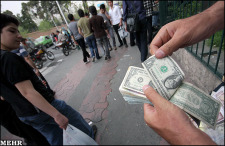Iran Feature: The Economy --- The State of the Nation (Khajehpour)
See also Iran Feature: The Economy --- Assessing The Real Rate of Unemployment
 The Middle East Program of the Wilson Center for International Scholars in Washington DC has posted a series of papers, "Iran: Turmoil at Home, Assertiveness Abroad". The collection includes this assessment by Bijan Khajehpour, "The Impact on Internal and External Tensions on the Iranian Economy":
The Middle East Program of the Wilson Center for International Scholars in Washington DC has posted a series of papers, "Iran: Turmoil at Home, Assertiveness Abroad". The collection includes this assessment by Bijan Khajehpour, "The Impact on Internal and External Tensions on the Iranian Economy":
For decades, the Iranian economy has produced mixed signals which are difficult to interpret. On the one side, the country’s Gross Domestic Product (GDP) keeps growing (at an average of about 5 percent over the last decade and about 3 percent over the past 3 years), which is mainly explained through the country’s vast resource base and the higher than expected oil prices in recent years. On the other side, the economy produces alarming indicators in inflation, unemployment, budget deficit, etc. as it continues to suffer from a host of internal and external processes such as the consequences of subsidy reforms, the effect of sanctions, as well as quasi privatization.
The fact that the country’s economy is heavily interdependent with political developments can be clearly seen in the recent banking scandal in Iran. The developments surrounding a $2.6 billion embezzlement case (the largest in the country’s history) involving eight banks has already led to the sacking of three managing directors --- Mahmoud Reza Khavari of Bank Melli, Mohammad Jahromi of Bank Saderat, and Vali Zarrabieh of Bank Saman. These were the first three heads to roll, but others will emerge, especially in the field of politics. Analysts argue that the embezzlement case is proof of the existence of a network of complex webs that operate across business and political sectors with the aim of monopolizing key opportunities in the Iranian economy.
To assess the interrelationship between economic realities and domestic as well as foreign policy developments, this article will look at the current economic realities through the lens of actual indicators, analyze key domestic and external developments that have had an impact on the Iranian economy, and offer an economic outlook for the short- to medium-term.
The Current Economic Picture
A look at the current economic phenomena underlines the following facts:
*Inflation remains high and on the rise as a result of subsidy reforms and the subsequent budget deficit. Experts agree that the government’s populist policies have been the main cause of high inflation, but the most significant contributor to the current inflation is the shift in subsidy policies;
*The sharp rise in energy prices as well as the liquidity growth as consequences of subsidy reforms have increased the inflationary pressures on the economy;
*In the last Iranian year (ending March 2011), Iran’s real GDP grew by 3.2 percent; but for the current year, Iran will experience a growth of about 2.5 percent—both figures are considerably lower than the planned growth of 8.0 percent. This means that unemployment will continue to rise in the absence of needed economic growth and job creation;
*Youth unemployment is considered Iran’s main socio-economic issue, which will not go away for some time due to demographic realities;
*Official and unofficial UN, U.S., and EU sanctions have had a negative impact on economic performance—the impacts have been direct and indirect, but they need to be seen as an important factor in the country’s ability to achieve its own economic and industrial objectives;
*Despite all negative developments, the country’s GDP has been on the rise. Based on the UN’s Purchasing Power Parity (PPP) calculations, in 2011 Iran’s GDP stands at $848 billion, i.e., a PPP-based per capita GDP of $10,917.
*Inflation: The reason that unofficial inflation is much higher than official inflation is that a number of items in the basket of goods used by the Central Bank of Iran (CBI) rely on lower subsidized prices, whereas the calculation of unofficial inflation mainly relies on non-subsidized goods and services;
*Unemployment: This is one of the most challenging socio-economic phenomena in Iran. It is mainly driven by the country’s demographic profile (with the age groups between 15 and 30 representing almost 40 percent of the population). In fact, youth unemployment currently stands at 27 percent. The level of unofficial unemployment relates to the prevalence of “underemployment,” i.e., the mismatch between university graduates and job opportunities. The Iranian economy has failed to produce jobs in line with the rate of emerging university graduates.
Unemployment and underemployment remain the most disturbing parameters in the Iranian economy with many socio-economic consequences. Unfortunately, as a result of the subsidy reforms, unemployment will grow faster than previously anticipated . As economic indicators underline, the government policies have failed to create sustainable jobs as they have mainly focused on short-term employment opportunities.

 Thursday, December 15, 2011 at 9:17
Thursday, December 15, 2011 at 9:17
Reader Comments